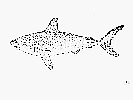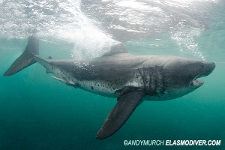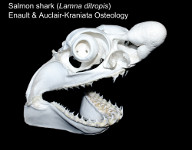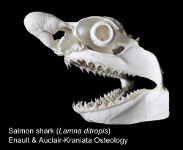Lamna ditropis
Hubbs & Follett, 1947
Salmon shark
Classification: Elasmobranchii Lamniformes Lamnidae
Reference of the original description
Lamna ditropis, new species, the salmon shark of the North Pacific. Copeia, 1947(3), 194
Lamna ditropis, new species, the salmon shark of the North Pacific. Copeia, 1947(3), 194
Image of the original description
No image in first description.
No image in first description.
Synonyms / new combinations and misspellings
Lamna cf. ditropis
Lamna cf. ditropis
Description :
Citation: Lamna ditropis Hubbs & Follett, 1947: In: Database of modern sharks, rays and chimaeras, www.shark-references.com, World Wide Web electronic publication, Version 12/2025
Please send your images of "Lamna ditropis" to info@shark-references.com
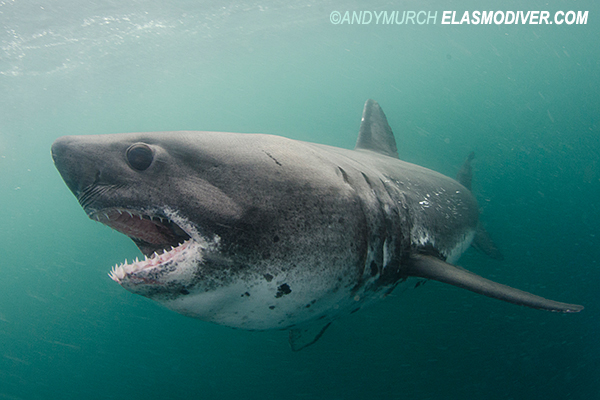
Lamna ditropis Hubbs & Follett, 1947, © Andy Murch Elasmodiver

Lamna ditropis Hubbs & Follett, 1947, © Andy Murch Elasmodiver
Common names
 Atlantischer Heringshai,
Atlantischer Heringshai,  Heringshai,
Heringshai,  Menschenhai,
Menschenhai,  Pazifischer Heringshai,
Pazifischer Heringshai,  Calderón,
Calderón,  Ludia,
Ludia,  Marraco,
Marraco,  Marraix,
Marraix,  Marrajo,
Marrajo,  Marrajo salmón,
Marrajo salmón,  Marraquet,
Marraquet,  Tauló,
Tauló,  Tiburón,
Tiburón,  Tiburón carito,
Tiburón carito,  Tiburón salmón,
Tiburón salmón,  Lami,
Lami,  Lamie,
Lamie,  Maraiche,
Maraiche,  Mélantoun,
Mélantoun,  Requin long-nez,
Requin long-nez,  Requin-taupe saumon,
Requin-taupe saumon,  Squale-nez,
Squale-nez,  Taupe de mer,
Taupe de mer,  Taupe du Pacifíque,
Taupe du Pacifíque,  Touille boeuf,
Touille boeuf,  Mackerel shark,
Mackerel shark,  Porbeagle,
Porbeagle,  Salmon shark
Salmon shark
 Atlantischer Heringshai,
Atlantischer Heringshai,  Heringshai,
Heringshai,  Menschenhai,
Menschenhai,  Pazifischer Heringshai,
Pazifischer Heringshai,  Calderón,
Calderón,  Ludia,
Ludia,  Marraco,
Marraco,  Marraix,
Marraix,  Marrajo,
Marrajo,  Marrajo salmón,
Marrajo salmón,  Marraquet,
Marraquet,  Tauló,
Tauló,  Tiburón,
Tiburón,  Tiburón carito,
Tiburón carito,  Tiburón salmón,
Tiburón salmón,  Lami,
Lami,  Lamie,
Lamie,  Maraiche,
Maraiche,  Mélantoun,
Mélantoun,  Requin long-nez,
Requin long-nez,  Requin-taupe saumon,
Requin-taupe saumon,  Squale-nez,
Squale-nez,  Taupe de mer,
Taupe de mer,  Taupe du Pacifíque,
Taupe du Pacifíque,  Touille boeuf,
Touille boeuf,  Mackerel shark,
Mackerel shark,  Porbeagle,
Porbeagle,  Salmon shark
Salmon shark
Short Description
First dorsal fin uniformly dark, no light rear tip; ventral surface of body white with dusky blotches [518].
First dorsal fin uniformly dark, no light rear tip; ventral surface of body white with dusky blotches [518].
Distribution
North Pacific: Japan, Korea, and the Sea of Okhotsk to the Bering Sea and southward to southern California, USA [518] and Baja California, Mexico (Ref. 9253). Source: www.gbif.org
North Pacific: Japan, Korea, and the Sea of Okhotsk to the Bering Sea and southward to southern California, USA [518] and Baja California, Mexico (Ref. 9253). Source: www.gbif.org
Human uses
fisheries: minor commercial; gamefish: yes; price category: not marketed/unknown; price reliability:
fisheries: minor commercial; gamefish: yes; price category: not marketed/unknown; price reliability:
Biology
Exhibit ovoviparity (aplacental viviparity), with embryos feeding on other ova produced by the mother (oophagy) after the yolk sac is absorbed [733]. Litter size is up to 4 young [518]. Distinct pairing with embrace [17086]. A carnivore [17641].
Exhibit ovoviparity (aplacental viviparity), with embryos feeding on other ova produced by the mother (oophagy) after the yolk sac is absorbed [733]. Litter size is up to 4 young [518]. Distinct pairing with embrace [17086]. A carnivore [17641].
Habitat
pelagic-oceanic; oceanodromous [17660]; marine; depth range 0 - 650 m (Ref. 50550), usually 0 - 152 m (Ref. 55221)
pelagic-oceanic; oceanodromous [17660]; marine; depth range 0 - 650 m (Ref. 50550), usually 0 - 152 m (Ref. 55221)
Remarks
shark-references Species-ID=3415;
shark-references Species-ID=3415;
Parasites (arranged by Jürgen Pollerspöck)
Cestoda
Copepoda
Cestoda
- Clistobothrium tumidum (Linton, 1922) [16383] [16443]
- Dinobothrium septaria (Van Beneden, 1889) [16383]
- Nybelinia sp. [16112]
- Nybelinia surmenicola Okada in Dollfus, 1929 [16112] [17919] [33697]
Copepoda
- Anthosoma crassum (Abildgaard, 1794) [34105]
- Echthrogaleus coleoptratus (Guérin-Méneville, 1837) [16599]








